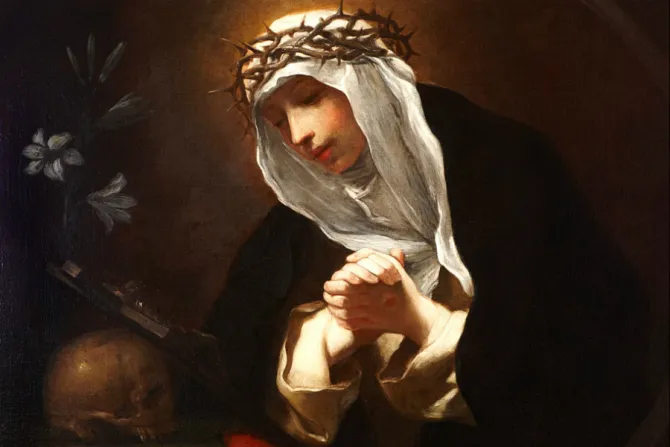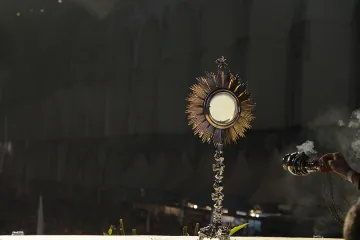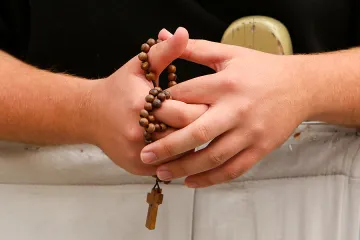Siena, Italy, Dec 26, 2018 / 05:02 am
When St. Catherine of Siena was alive in the 14th century in what is now Italy, it looked like it was the end of the world.
The Bubonic plague was sweeping through Europe in waves, which would ultimately wipe out 60 percent of the population. The Papal States were divided and at war. Rich churchmen were buying their positions; bishops were making sure their family members would succeed them. The pope had been living in France for 70 years, and though he would return to Rome, the Western Schism happened shortly after, with three claimants to the See of Peter.
"She lived in really terrible times," Fr. Thomas McDermott, O.P., a St. Catherine of Siena scholar, told CNA. "And people really did think it was the end of the world."
The state of the world, and the Church today, is different, though in some ways no less troubled. The new wave of sex abuse scandals and their alleged cover-ups have rocked anew the Church throughout the world.
When St. Catherine talked about the Church, she often referred to it as the Body of Christ, in the tradition of St. Paul, McDermott noted.
"She says the face of the Church is a beautiful face, but we're pelting it with filth," he said. "It has a beautiful face, that's the divine side of the Church, but we human beings are pelting it; we're disfiguring the body of Christ through our sins."
While the current abuse crisis and related scandals have left many lay Catholics wondering how to respond, some Catholics have suggested looking to the saints - like Catherine of Siena - for guidance.
Who was Catherine?
Catherine was born March 25, 1347, the 25th child born to middle-class parents in Siena; about half of her siblings did not survive childhood.
At a young age, she became very devout, and resisted her parents when they attempted to have her marry the husband of one of her sisters who had died. Instead, she chose to fast and cut off her hair to make herself less desirable. She would ultimately vow her virginity to Christ, and experienced a mystical marriage to him around the age of 21.
Instead of entering a convent, however, Catherine chose to live a life of prayer and penance at home as a tertiary, or third order, Dominican. She spent several years in near-seclusion, in a cell-like room under the steps in her parents' house, spending her days in dialogue with Christ.
After several years of this at-home novitiate of sorts, while in her mid-20s, she heard Christ telling her to lead a more public life.
"He said now you have to go out and share the fruits of your contemplation with others," McDermott said. "That's very Dominican, it's from the Summa of St. Thomas Aquinas."
Catherine obeyed, and rejoined her family in their daily activities. She also began to serve the poor, and soon became renowned for her charitable works. She gathered a following of young men and women - many of them from rich families of high social status - because they enjoyed her warm personality and her holiness.
Catherine goes public - and gets political
Once she stepped back into a more public life, she became more connected and in tune with the happenings in the Church.
(Story continues below)
At the time, Gregory XI was living in Avignon and was at war with the Republic of Florence. He placed it under interdict; essentially the equivalent of excommunicating a city - they were cut off from receiving the sacraments, among other sanctions.
Through her life of prayer and her consultation with her spiritual directors, Catherine began corresponding with papal representatives and the pope himself, attempting to broker peace in Florence and advocating for reform where she saw corruption.
"The papal nuncio to Florence in Catherine's time is grossly hated by the powerful families in Florence, and he's hated because the powerful families feel that they've been mistreated by the Pope," said Catherine Pakaluk, an associate professor of economics at Catholic University of America and a devotee of St. Catherine.
"She's writing to the nuncios, she's writing to the pope, and she's trying to prevent this internal Catholic war between these parts of the Papal States," she said. "And this is before the Great Schism when things get really bad."
Tempers and tensions were so high that the papal nuncio of Florence was eventually skinned alive in the streets.
"So when we think about things today and how shocking and horrifying (they are), you know, things were pretty bad then," Pakaluk noted. "The nature of the particular crimes is different, but the tensions were really high and these folks were quite violent."
Catherine was drawn into the Church politics of her time not because of a misplaced sense of ambition, McDermott said, but because she loved the Church as she loved God.
"It wasn't her motive to be involved in the politics of the Church, but what was best for everyone and for the church led her into politics," he said. "But it's not like she was interested in politics itself."
As part of her attempts at solving the problems of the Church, Catherine joined the call of many other Catholics of the time for the Pope to return to Rome.
After some correspondence, Catherine set out on foot with her followers to go meet with the pope in person.
"It was a remarkable thing for Catherine who was a homebody to take off on foot for France with her disciples, but she was prepared to do anything for the Church because the Church was the Body of Christ," McDermott said.
After scores of people pleading with the pope to return to Rome between 1309 and 1377, St. Catherine seemed to prove most persuasive.
During her visit, Catherine referenced parts of the pope's dream, about which he had told no one.
"It was astounding to him (that she knew about the dream) and he took that as a clear sign from God that he was speaking to him through this woman," McDermott said. So after decades of exile, within a few weeks of Catherine's visit, the pope packed up his things and headed back to Rome.
"She's a great example of a laywoman who had strong convictions about the Church and was not timid about expressing them," said Dr. Karen Scott, an associate professor of Catholic Studies and History at DePaul University in Chicago.
"It was a very different situation from today, so it would be a mistake to think that it's an automatic equivalent" to the problems of the current Church, Scott told CNA.
"She was living a long time ago and it was a different time and a different Church and different historical set of circumstances...but she was aware of all sorts of problems with the clergy and she believed they ought to be reformed."
The legend of the opinionated laywoman
What Catherine excelled at in her correspondence with the pope and other clergy was her ability to balance her no-punches-pulled critiques with her profound respect for the Church and the papacy, Scott said.
"There's a beautiful balance between clear thinking and the ability to see the flaws...but at the same time to be enormously respectful of the Church and the papacy in particular and to base all of this on her deep spiritual life, a life of deep prayer," Scott said.
"She's a laywoman who had strong opinions and views on (Church matters) and took action, and amazingly they paid attention," Scott added. Amazingly, because she was an uneducated lay woman from a modest background who wasn't particularly well-known.
"They listened to her because what she was saying was so obviously right and sincere and coming out of her prayer and the Gospel," Scott said.
In total, Catherine wrote at least 381 letters in her lifetime. Three years before her death, she also began dictating "Il Libro" ("The Book"), a collection of her spiritual teachings and conversations with God that became known as "The Dialogue".
A significant portion of her Dialogue, chapters 110-134, gives insight into her thoughts on the Church reforms needed at the time. Catherine relayed that the "Eternal Father" (how she frequently refers to God the Father) had told her that the biggest problem facing the secular priests of her time was money, while the biggest problem facing priests in religious orders was homosexuality.
Her frank critiques were considered so indelicate that they were excised from many of the English translations of her book, McDermott said.
"She was writing this in the 1300s, she believes it was dictated to her by the Eternal Father, and she's always a direct hitter, she doesn't hold anything back," McDermott said.
But while her dialogues contain punchy critiques of the clergy, she also urged respect for them at the same time, as they are "Christs" on earth who bring Jesus to the world through the Eucharist.
"You should love them (priests) therefore by reason of the virtue and dignity of the Sacrament, and by reason of that very virtue and dignity you should hate the defects of those who live miserably in sin, but not on that account appoint yourselves their judges, which I forbid, because they are My Christs, and you ought to love and reverence the authority which I have given them," the Eternal Father told Catherine, as recalled in her Dialogue.
While Catherine was successful at bringing the papacy back to Rome and brokering peace between Florence and the Eternal City, the period known as the Great Schism, or the Western Schism, would begin just two years before her death.
"It wasn't crystal clear who the real pope was," McDermott said, noting that even some saints who are now canonized had sided with opposing claimants at the time. "So that must have also seemed like the end of the world."
"St. Catherine was totally horrified," Scott said, "because for her, Church unity was really essential."
During this time, French cardinals had elected a leader as the Pope, and later on, the Council of Pisa also elected a claimant. St. Catherine sided with the claimant residing in Rome, Urban VI, and moved there in the last few years of her life to advocate for him and offer intense prayer and penance for the Church.
When she died in 1380, a result of illness brought on by her extreme penances, the western Church was still in schism, and would remain that way until the conclusion of the Council of Constance in 1418.
"Some historians, I think specifically less faithful ones or who don't have a life of faith...will say well Catherine really failed, because her goal was to bring the Pope back to Rome to heal the divisions in the Church, but how could she have succeeded if the greatest schism of the Western Church occurs after she dies?" Pakalu said.
"I don't know that's quite the right view. We never know the hypothetical of history, we never know what would have happened without Catherine's influence, and she does at least initially bring the Holy Father back to Rome before she died and that was pretty important," she said.
"My guess is that the Church was able to survive the Great Schism because she got certain things lined up before she died."
Catherine's lessons for Catholics today
"What would she say today? I think that's a dangerous question," Scott said, "because we can't say how she would relate to the current issues and complex questions, except that she would know very well what the moral stance is, that bishops and priests and lay people should all follow."
Catherine would set the highest of standards for honesty and integrity and pastoral concern for the laity, Scott said, as well as the highest standards "for avoiding schism and being close to the papacy."
"Beyond that I think she would advise people to take the time to pray and discern and not have knee-jerk reactions to things," she added.
Pakaluk said that she thinks there are three lessons to be learned from Catherine's life and example, with the first being that any activist role in Church politics must be rooted in deep prayer and love for the Church.
"I wouldn't say don't get involved until you're as holy as Catherine … but to do activism or public ministry without that deep commitment to prayer would be completely absurd and would not be faithful to her life or her example," she said.
The second lesson, she said, would be to take the long view of history. The Church has survived hard times and scandal before, and she can survive them again.
"I am horrified at outraged at what I'm seeing and hearing about" regarding the current scandals, Pakaluk said.
"But I'm not personally disturbed, my faith isn't challenged, because I'm so familiar with (ages) in the Church's past, particularly and especially the one that Catherine lived through, in which there was so much corruption and so much disappointment on the part of the faithful with respect to the hierarchy and some members of the clergy," she said.
"So it doesn't disturb me because I think well, why would it be different? Why would we think we're better? Why do we think we're completely immune to some of the things that have occurred in the past?"
The third thing Catholics can learn from St. Catherine is that it is possible to be a saint even in the most trying times in the Church, Pakaluk said.
"She's there in Heaven, she ran the race, she made it," she said. "We can look at her not only like 'we can do it too', but she's our older sister, and we can follow her and ask her to intercede for us."
McDermott said that Catholics should be heartened by St. Catherine's witness because even while she prolifically wrote about the problems of the Church, she never once hinted that she was thinking about leaving.
"She would've said don't leave the Church, this is the human, sinful side of the Church that is being reflected. And the good of the church - stay and purify it," he said.
"Our love for Christ and the Church - the two are inseparable - is shown in hard times when it doesn't feel very good to be a Catholic, that we keep on walking with Christ and the Church."
This article was originally published on CNA Sept. 16, 2018.





